
Ancient Bronze Weapons
Chinese bronze objects first appeared about six thousand years ago at the end of the Stone Period and the beginning of the Metal
Age. Weapons made of bronze were predominant in China for about four thousand years at which point iron weapons became
popular.
Age. Weapons made of bronze were predominant in China for about four thousand years at which point iron weapons became
popular.
Here we show some pictures of ancient bronze weapons which have been excavated in China. Beautiful and historically
interesting, they come from different ancient dynasties. Although the earliest of them dates from the Xia Dynasty (2100 BC -
1600 BC), it was during the Shang Dynasty (1600 BC - 1100 BC) that the technology of making bronze weapons was developed
to a high level. Bronze weapons of excellent quality were produced throughout the following West Zhou Dynasty (1100 BC -
771 BC), the Spring and Autumn Period (770 BC - 476 BC) and the Waring States Period (475 BC - 221 BC). Most of the
weapons unearthed today come from these time spans. Iron weapons began to appear toward the end of the Warring States
Period and quickly came into general use. Both bronze and iron weapons were used during the Qin Dynasty (221 BC - 207 BC),
but bronze weapons were soon eclipsed by those of iron. Although bronze was used much earlier than iron, more bronze
weapons have been unearthed than iron because bronze decays or rusts much slower than iron when under the earth.
interesting, they come from different ancient dynasties. Although the earliest of them dates from the Xia Dynasty (2100 BC -
1600 BC), it was during the Shang Dynasty (1600 BC - 1100 BC) that the technology of making bronze weapons was developed
to a high level. Bronze weapons of excellent quality were produced throughout the following West Zhou Dynasty (1100 BC -
771 BC), the Spring and Autumn Period (770 BC - 476 BC) and the Waring States Period (475 BC - 221 BC). Most of the
weapons unearthed today come from these time spans. Iron weapons began to appear toward the end of the Warring States
Period and quickly came into general use. Both bronze and iron weapons were used during the Qin Dynasty (221 BC - 207 BC),
but bronze weapons were soon eclipsed by those of iron. Although bronze was used much earlier than iron, more bronze
weapons have been unearthed than iron because bronze decays or rusts much slower than iron when under the earth.
Ge: The most popular Chinese long weapon used in ancient times was the Ge. In the very beginning, people
just tied a piece of stone on top of a staff as a weapon. When bronze was used, people made many beautiful
Ge heads. In the ancient world, soldiers fought from "fighting wagons" using long weapons. Ge was very useful
for this. When rider horse became popular, Ge was obsolete generally. Ge remained in use through the Three
Kingdom Period (220 - 265).
just tied a piece of stone on top of a staff as a weapon. When bronze was used, people made many beautiful
Ge heads. In the ancient world, soldiers fought from "fighting wagons" using long weapons. Ge was very useful
for this. When rider horse became popular, Ge was obsolete generally. Ge remained in use through the Three
Kingdom Period (220 - 265).

Because Ge was the most popular weapon in the ancient, it is common that it means fighting or war. The
importance and popularity of Ge are reflected in the Chinese character WU meaning "martial." This character
is made up of two parts: one, ZHI, means "stop"; the other, GE, is usually translated as "fighting." "Martial,"
therefore, means to stop fighting. There a important Chinese idea is that martial arts is not for fighting, is for
stop fighting.
importance and popularity of Ge are reflected in the Chinese character WU meaning "martial." This character
is made up of two parts: one, ZHI, means "stop"; the other, GE, is usually translated as "fighting." "Martial,"
therefore, means to stop fighting. There a important Chinese idea is that martial arts is not for fighting, is for
stop fighting.
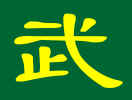
The Ge heads shown here came from several different dynasties. Usually, one Ge would have been tied on top
of a long staff but occasionally, two or three Ge heads would be attached to one staff.
of a long staff but occasionally, two or three Ge heads would be attached to one staff.
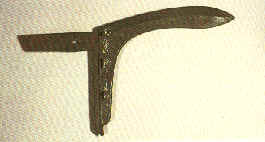
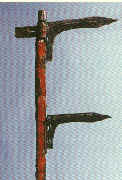
| Tenghao Ge, Spring and Autmn Period, 26cm, unearthed from Shandong province |
| Zeng Hou double Ge Ji, Warring States Period, total long 310cm, unearthed from Hubei province |
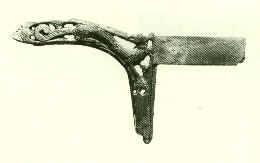

| Taibao Ge, West Zhou, 33cm, unearthed from Henan province |
| Dragon grain Ge, Warring States Period, unearth from Hunan |
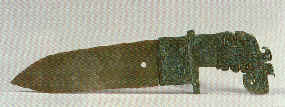
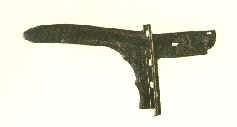
| Shang Dynasty, bride grains Ge length 27.8cm, unearthed from Henan province |
| Yan Zhao Wang's Ge, 25.2cm, Warring States Period, unearthed from Hebei province |

Jian: The most commonly used Chinese weapon overall is Jian, the straight double-edged sword. Not just a
weapon, it also symbolizes many values of traditional Chinese culture and character. In the Spring and Autumn
Period and the Warring States Period, bronze Jians of very high quality were produced. They were respected
and revered as holy weapons. Many legends of heroes and their wondrous deeds date from these periods.
weapon, it also symbolizes many values of traditional Chinese culture and character. In the Spring and Autumn
Period and the Warring States Period, bronze Jians of very high quality were produced. They were respected
and revered as holy weapons. Many legends of heroes and their wondrous deeds date from these periods.


King Yue - Gojian's jian, Spring
and Aotumn Period, 55.7cm,
unearth from Hubei
and Aotumn Period, 55.7cm,
unearth from Hubei
King Wu - Gelu's jian, Spring and
Aotumn Period, 50.7cm, unearth
from Shanxi
Aotumn Period, 50.7cm, unearth
from Shanxi


Chanhou Jian, Warring States
Period, 62.2 cm, unearth
Hunan Province
Period, 62.2 cm, unearth
Hunan Province
Fanyang Jian, Warring States
Period, 45 cm, unearthed from
Henan Province
Period, 45 cm, unearthed from
Henan Province
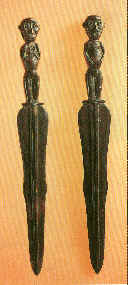

Yin and Yang short pair of jian,
Spring and Aotumn Period,
21.6cm, unearth from internal
Mengoliya
Spring and Aotumn Period,
21.6cm, unearth from internal
Mengoliya
Animal grain short jian, Spring
and Aotumn Period, 28.5cm,
unearth from internal Mengoliya
and Aotumn Period, 28.5cm,
unearth from internal Mengoliya
Qiang or spear is the most popular of the Chinese long weapons. Through many centuries of practice and
research, spear skills were developed to such a high level that defense against spear skills became the most
challenging of all defensive maneuvers. At the same time, of course, strategies and skills for such defensive
maneuvers were avidly sought. Here we show some ancient spearheads. Although they are of varying shapes,
more attention was actually paid to the quality and production of a spear's staff than to the spear's head.
research, spear skills were developed to such a high level that defense against spear skills became the most
challenging of all defensive maneuvers. At the same time, of course, strategies and skills for such defensive
maneuvers were avidly sought. Here we show some ancient spearheads. Although they are of varying shapes,
more attention was actually paid to the quality and production of a spear's staff than to the spear's head.


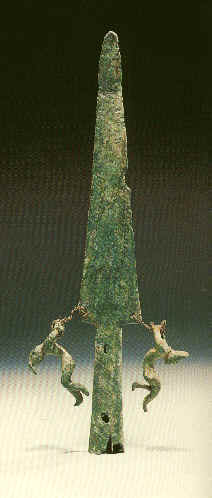
Tied Captures Spear Head,
West Han Dynasty, 41.5
cm, unearthed from Yunnan
Province
West Han Dynasty, 41.5
cm, unearthed from Yunnan
Province
Jade spear head. 18.4cm,
Shang Dynasty
Shang Dynasty
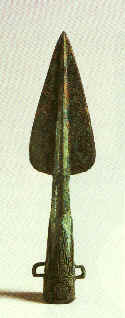

King Wu - Fuchai's spear, Spring and Autom
Period, 29.5cm, unearthed from Hubei province
Period, 29.5cm, unearthed from Hubei province
Spear head, Shang Dynastry,
24.3cm
24.3cm
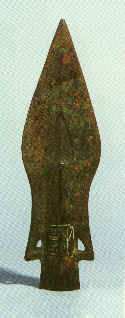

Spear head, Warring States Period,
22.5cm, unearth from Sichuan Province
22.5cm, unearth from Sichuan Province

Spear head,
Shang Dynastry,
23.1cm
Shang Dynastry,
23.1cm
Spear Head, Warring States Period,
15cm, unearthed from Guangxi province
15cm, unearthed from Guangxi province

Fu, an axe, is not a common military weapon but it was commonly used by members of the security
forces guarding emperors, kings, nobles or generals. It symbolized the power and prestige of the
guard’s high-ranking employer.
forces guarding emperors, kings, nobles or generals. It symbolized the power and prestige of the
guard’s high-ranking employer.


Dragon grain axe,
Shang Dynasty,
unearthed from
Shanxi province
Shang Dynasty,
unearthed from
Shanxi province
Face grain axe,
Shang Dynasty,
unearthed from
Shandong province
Shang Dynasty,
unearthed from
Shandong province
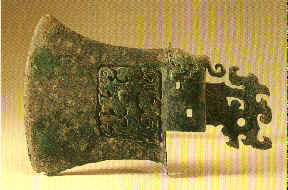
Dragon boat axe,
Spring and Aotumn
Period, 9.9 * 12.1
cm, unearthed from
Zejiang province
Spring and Aotumn
Period, 9.9 * 12.1
cm, unearthed from
Zejiang province
| ¡@ |
Dragon and tiger grain axe,
Shang Dynasty, unearthed
from south of China
Shang Dynasty, unearthed
from south of China

Dao or saber, became a popular weapon much later than Jian. Sabers made of bronze are, therefore, rare.
By the time iron was widely used for the manufacture of weapons, Dao rather than Jian had become the
predominant military short weapon. The shape of Dao has changed a lot over time so that today there are
many different variations.
By the time iron was widely used for the manufacture of weapons, Dao rather than Jian had become the
predominant military short weapon. The shape of Dao has changed a lot over time so that today there are
many different variations.


| Sheep head dagger, 30.2 cm, unearthed from Hebei province |
| Horse head sword, Shang Dynasty, 32 cm, unearthed from Shanxi province |


| Cloud grain sword, Warring States Period, 14cm, unearthed from Hubei |
| Mulei grain sword, Shang Dynasty, 38.7 cm |
Other Weapons: In China there are many different kinds of weapons. Usually, people refer to the "Eighteen
Weapons" but there are many different versions of exactly which weapons are included in this count. In fact, the
specific number is not important. It is meant to convey only that many weapons have been designed and used
throughout Chinese military and social history.
Weapons" but there are many different versions of exactly which weapons are included in this count. In fact, the
specific number is not important. It is meant to convey only that many weapons have been designed and used
throughout Chinese military and social history.



| Zenghouyi Arrow heads, Warring States Period, 67 - 71 cm with staffs, unearthed from Hubei Province |
| Zenghou Shu, Warring States Period, 329cm with staff, unearthed from Hubei Province |
| JinTuo, Warring States Period, 320cm with staff, unearthed from Hubei Province |
Yin Cheng Gong Fa Association North American Headquarters
Copyright © 2000 YCGF_NAH. All rights reserved.
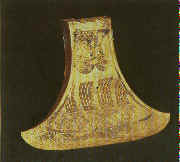
=======================================================================================================